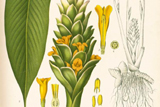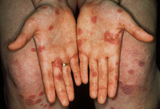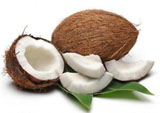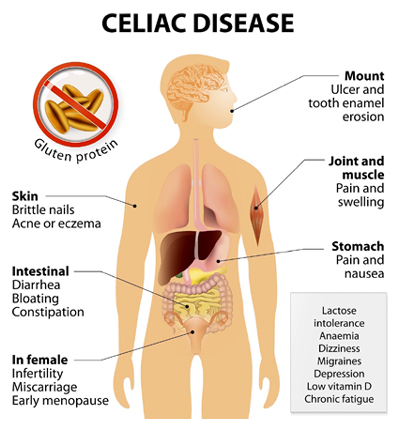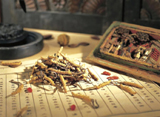Medicinal plants
Turmeric: a natural anti-inflammatory tonic
Abstract
This article aims to enlighten readers on the many ways turmeric can enhance health when taken internally as food and beverage, externally as health and beauty products and therapeutically as supplements to manage, slow and with daily usage, alone or with modern medicine, reverse chronic disease states.
Background and uses
Turmeric or Curcuma longa, while a spice native to south Asia, appears to have migrated to the Far East, the Middle-East and the West via the silk route, as the spice trade thrived, going back about 5000 years. Turmeric is a pungent spice that forms the basis for many curry powders. It is also used as a natural food colourant. Traditionally, turmeric has been used to heal bruises, sprains, leech bites, inflamed joints, severe chest congestions and common colds.
Plant specifics
Turmeric is derived from Curcuma longa, a rhizomatous herbaceous perennial plant belonging to the ginger family,Zingiberaceae. The plant grows an underground tuber, or rhizome much like ginger does. It can take between 8 to 10 months for a new crop of roots to develop and it is not a plant that you can harvest in small pieces through the season.
As many as 133 species of Curcuma have been identified worldwide. Most of them have common local names and are used for various medicinal formulations. The turmeric plant needs temperatures of between 20°C and 30°C and a considerable amount of annual rainfall to thrive. Individual plants grow to a height of 1 metre and have long, oblong leaves. Plants are gathered annually for their rhizomes and are reseeded from some of those rhizomes in the following season. The rhizome, from which the turmeric is derived, is tuberous, with a rough and segmented skin. The rhizomes mature beneath the foliage in the ground. They are a yellowish-brown with a dull orange interior. The main rhizome is pointed or tapered at the distal end and measures 2.5-7.0 cm (1-3 inches) in length and 2.5 cm (1 inch) in diameter, with smaller tubers branching off. When the turmeric rhizome is dried, it can be ground to a yellow powder producing a bitter, slightly acrid, yet sweet, taste.
Active constituents
The rhizome or the root part of turmeric is the part used medicinally. More than 100 components have been isolated from turmeric. The main component of the root is a volatile oil, containing turmerone and there are other colouring agents called curcuminoids in turmeric. Curcuminoids consist of curcumin demethoxycurcumin, 5’-methoxycurcumin, and dihydrocurcumin, which are found to be natural antioxidants (1,2). The yellow-pigmented curcuminoids represent 2 -5% of the root, typically 85% as curcumin, 10% as demethoxycurcumin and 5% as disdemethodoxyycurcumin. Curcumin is the most studied component.
Traditional medicines
In Āyurvedic medicine, turmeric is thought to have many medicinal properties, including strengthening the overall energy of the body, relieving gas, dispelling worms, improving digestion, regulating menstruation, dissolving gallstones and relieving arthritis. Many south Asian countries use it as an antiseptic for cuts, burns and bruises, and as an anti-bacterial agent, for respiratory conditions (e.g. asthma, bronchial hyperactivity and allergy), as well as for liver disorders, anorexia, rheumatism, diabetic wounds, runny nose, cough and sinusitis (3). In traditional Chinese medicine, it is used to treat diseases associated with abdominal pain (4).
From ancient times, as prescribed by Āyurveda, turmeric has been used to treat sprains and swelling (5). In both Āyurvedic and traditional Chinese medicine, turmeric is considered a bitter digestive and a carminative. Yunānī (the term for Perso-Arabic traditional medicine as practiced in Mughal India and in the Muslim culture of south Asia and modern day central Asia) practitioners also use turmeric to expel phlegm or kapha, as well as to open blood vessels in order to improve blood circulation. It can be incorporated into foods, including rice and bean dishes, to improve digestion and reduce gas and bloating. It is a cholagogue, stimulating bile production in the liver and encouraging excretion of bile via the gallbladder, which improves the body’s ability to digest fats. Sometimes turmeric, mixed with milk or water, is taken to treat intestinal disorders as well as colds and sore throats.
Uses in modern medicine
Scientific research over the past 50 years, has demonstrated that curcumin (diferuloylmethane), a component of turmeric (Curcuma longa), can modulate cell signalling pathways. Extensive clinical trials have been conducted addressing pharmacokinetics, safety and efficacy against several diseases in humans. Certain promising effects have been observed in patients with various pro-inflammatory diseases such as arthritis, cancer (brain, breast, colon, prostate, colorectal, pancreatic, melanoma) cardiovascular disease, diabetes, Crohn’s disease, ulcerative colitis, irritable bowel syndrome, peptic ulcer, gastric ulcer, gastric inflammation, psoriasis, acute coronary syndrome, atherosclerosis, lupus, nephritis, renal conditions, vitiligo, AIDs, chronic arsenic exposure , alcohol intoxication and hepatic conditions (6).
In dose escalating studies, turmeric has been shown to be safe at as high a dose as 12 g/day for over 3 months. Various formulations have been studied including nanoparticles, liposomal encapsulation, emulsions, capsules, tablets and powder. Some of these delivery mechanisms have managed to improve its bioavailability, metabolism and pharma-cokinetics (7).
Though curcumin has shown efficacy against numerous human ailments, poor bio-availability due to poor absorption, rapid metabolism, and rapid systemic elimination, has been shown to limit its therapeutic efficacy (8). As a result, numerous efforts have been made to improve curcumin’s bioavailability by altering these features. The use of adjuvants that can block the metabolic pathway of curcumin is the most common strategy for increasing the bio-availability of curcumin. The effect of combining piperine (black pepper), a known inhibitor of hepatic and intestinal glucuronidation, was evaluated on the bioavailability of curcumin in healthy human volunteers (9). In humans receiving a dose of 2 g. of curcumin alone, serum levels of curcumin were either undetectable or very low. Concomitant administration of 20 mg of piperine with curcumin, however, produced much higher concentrations within 30 minutes to 1 hour after drug treatment; piperine increased the bioavailability of curcumin by 2,000%. The results imply that adding just one percent of piperine to turmeric could enable better absorption and metabolism.
Most of the curcumin clinical studies have been focused mainly on people with health problems. A recent study, however, evaluated the health-promoting efficacy of lipidated curcumin in healthy middle-aged participants (40-60 years-old). In this study, the participants were given either lipidated curcumin (80 mg/day) or placebo for 4 weeks. Curcumin, but not placebo, produced decrease in plasma levels of triglycerides and beta amyloid (plaque). Furthermore, curcumin administration in these participants increased free radical scavenging capabilities. These results demonstrated the health-promoting effects of lipidated curcumin in healthy middle-aged people (10). Adding ghee or extra virgin coconut oil to turmeric can better its absorption.
Health benefits of turmeric
• Potential benefits from regular use are numerous. They include improved circulation, the prevention of blood clots, and alleviation of menstrual and menopausal complaints.
• It can stimulate the flow of bile and thereby promote the digestion of fats and expedite the liver’s ability to detoxify fat soluble metabolic and environmental toxins, such as pesticides, herbicides, medications, and synthetic hormones given to commercial animals to increase their size and yield of milk and meat.
• Turmeric has hepato-protective activity and can help prevent viral or chemical induced liver damage, as well as enhancing hepatic glutathione, a powerful cell protector and phase 2 liver detoxification enzyme precursor.
• Turmeric is a powerful anti-inflammatory, immune-regulator and mild analgesic used in the amelioration of osteoarthritis, rheumatoid arthritis, and bursitis. It is also effective in the healing of inflammatory conditions of the GI tract such as ulcerative colitis, Crohn’s disease, celiac disease, gastritis and gastric ulcers.
• Turmeric gradually lowers blood pressure, reduces LDL cholesterol levels, oxidative damage to the liver, blood vessels (atherosclerosis) and eyes.
• Curcumin is used in the treatment of viral infections such as HIV, and Epstein Barr.
• Since the discovery of turmeric’s antioxidant phenolic compounds and the protection these compounds provide against free radicals, this spice is now viewed as much more than just an ingredient in curry or a yellow dye. Curcumin extracted from turmeric has been found to down-regulate over 70 pro-cancer cell signalling pathways and oncogenes (11).
Cancer: select clinical findings
Cancer: select clinical data |
|||
Duration |
Benefit |
Dosage |
|
| Breast cancer | 20 clinical trials |
Data suggest significant chemo preventative and anti-cancer potential for curcumin (12). |
500 – 8,000 mg. of curcumin per day. Standardised extracts in lower amounts between 250-2,000 mg. |
| Six days | This study demonstrated that 20–80 µM CUR significantly downregulates both p53 and ER protein levels with a concomitant decrease in T-47D cell viability. CUR alone caused a 10-fold decrease compared to the treatment with oestrogen, which suggests its anti-proliferative effects (13). |
T-47D cells were treated with 5–80 µM CUR for a duration of 24 hours along with variable amounts of curcumin. | |
Curcumin killed breast cancer cells by arresting their development in various phases of cell cycle and growth and inducing cell death (14). Curcumin nanoparticles were found to be more effective than curcumin in exerting anti-proliferative effect against breast cancer cells. It also prevented metastasis of breast cancer cells (15). |
DK1 a curcumin derivative’s, cytotoxicity was tested on breast cancer cell MCF-7 and normal cell MCF-10A. To examine the in vitro cytotoxic activity of cell death of curcumin and nanocurcumin on human breast adenocarcinoma cell line (MDA-MB231). Cytotoxicity and viability of curcumin and nanocurcumin were assessed by 3-(4,5-dimethylthiazol-2-yl)-2,5-diphenyltetrazolium bromide (MTT) and dye exclusion assay. |
||
Research by Saab et al. highlights that curcumin may be beneficial in treatment of non-malignant or benign breast tumours as well. A study published in Anticancer Research 2005, demonstrates that curcumin regulates as many as 30 genes and acts on multiple biochemical pathways in order to destroy breast cancer cells (16). |
In mammalian, non-malignant HMEC 184A1 and cancerous MCF-7 cells during curcumin treatment were investigated by utilising multiphoton, fluorescence, and atomic force (AFM) microscopies. | ||
| 3 weeks | Researchers have identified dosing for advanced metastatic breast cancer at 6000 mg and concomitant use with chemotherapy (17). |
6000mg. per day for 7 consecutive days every 3 weeks along with standard docetaxel treatment. |
|
| Topical treatment helped with external breast cancer lesions. 90% of individuals experienced a reduction in smell. Itching reduced in almost all cases. 70% of individuals experienced drying up of lesions. 10% of patients experienced reduction in lesion size and pain (18). |
An ethanol extract of turmeric (Curcuma longa) as well as an ointment of curcumin (its active ingredient) were found to produce remarkable symptomatic relief in patients with external cancerous lesions. |
||
| A study published in International Journal of Oncology, revealed that curcumin increases the apoptotic (apoptosis means cell death) effect of paclitaxel (chemotherapeutic drug) in breast cancer and its concomitant use may reduce the toxicity of the therapy (19). | Curcumin and paclitaxel were evaluated with two human breast cancer cell lines as the luminal MCF-7 and the basal-like MDA-MB-231 that are either positive or negative for hormonal receptors oestrogen receptor, progesterone receptor and HER2, respectively. | ||
| Researchers at University of Rochester Medical Center have proven that daily supplementation of turmeric significantly reduces the rate of radiation dermatitis in patients suffering from breast cancer and receiving radiotherapy (20) | 2g curcumin three times a day (total 6 g.) and radiotherapy. | ||
| Colorectal cancer | The body weight of curcumin patients increased approximately 4 % vs weight loss of 6% in the placebo group (21). | 360 mg curcumin 3 times per day followed by radiotherapy, chemotherapy, chemo-radiotherapy; or no additional therapy. |
|
| Lung cancer |
One month |
Turmeric dosing significantly reduced the urinary excretion of mutagens in smokers. Dietary turmeric can act as an effective anti-mutagen in smokers and can reduce the risk of lung cancer and cancer lesions (22). | 1.5 g. of turmeric for 30 days. 16 chronic smokers and 6 non-smokers were in the control group. |
| Multiple myeloma | Both 4g. and 8g. daily doses reduced the serum free light chain ratio (35% and 36%, respectively) and reduced total serum protein (P=0.04) in the urine in both MGUS and SMM patients Curcumin also decreased markers of bone turnover (urinary DPYD) and excretion of crosslinked N-telopeptides by more than 25% (23). | A double-blind placebo-controlled crossover of 19 patients with MGUS and 17 patients with smouldering MM examined the effects of daily curcumin. |
|
| Pancreatic cancer |
12 months | There was improvement of chemotherapy-related symptoms after starting curcumin. The median survival after initiation of curcumin was 161 days. One-year survival rate was 19%. Median survival after gemcitabine is 70 days (24). | 8 g. curcumin with gemcitabine (Gemzar). |
| Prostate cancer |
6 months |
Isoflavones and curcumin could modulate serum PSA levels. The authors of this study concluded that curcumin presumably synergizes with isoflavones to suppress PSA production (25). |
100 mg. of curcumin and 40 mg of isoflavones; and placebo. |
Other inflammatory diseases: select clinical findings
Other inflammatory diseases: select clinical data |
|||
Disease |
Duration, below |
Benefit |
Dosage |
| Arthritis | 8 months | Improved joint pain, stiffness, physical function, social and emotional function (26). | Curcuminoid and phosphotidylcholine 1000 mg. curcuma extract 200 curcuma extract daily. Standard conventional treatment. |
| Allergic rhinitis (AR) |
2 months | Curcumin alleviated nasal symptoms (sneezing and rhinorrhea) and nasal congestion through reduction of nasal airflow resistance. This pilot study provides the first evidence of the capability of curcumin of improving nasal airflow and modulating immune response in patients with AR (27). |
241 patients with AR received either placebo or oral curcumin. The therapeutic effects of curcumin were evaluated by nasal symptoms and nasal airflow resistance. |
| Asthma | 5 weeks | Findings suggest that curcumin administered through the nasal route might prove therapeutically efficient in inhibiting allergic airway inflammations and maintaining structural integrity in the mouse model of allergic asthma. This may lead to the development of curcumin aerosol in near future (28). |
Mouse study; short exposure to ovalbumin (4 days); repeated exposures for longer (twice per week till 5 weeks) represents chronic asthma. Disodium cromoglycate (DSCG, 50mg./kg., i.p.) and dexamethasone (1mg./kg., i.p.) were used as standard drugs in acute and chronic model of asthma respectively. |
| Cardio-vascular disease |
8 weeks |
Adding curcumin to regular exercise provides enhanced CV fitness in post-menopausal women (29). | 150 mg. curcumin with exercise training and placebo with exercise training. |
| Diabetes | 8 weeks | Significant increase in endothelial function in both the atorvastatin and curcumin groups. Additionally, all biomarkers decreased in the treatment group and no improvement in the placebo (30). |
300 mg. curcumin twice daily atorvastatin 10 mg. daily or placebo. |
| Irritable bowel syndrome |
8 weeks |
Prevalence of IBS decreased by 53% in the one-tablet group and 60% in the two-tablet group. Additional abdominal pain and discomfort decreased (31). | One of 72 mg. or two tablets of 72 mg. each, standardised turmeric extract taken daily for 8 weeks |
| Gastric ulcer |
Phase II | Ulcers completely healed in 48% after 4 weeks and 76% after 12 weeks. (32). |
600 mg with powdered turmeric 5 t/d Or placebo. |
Summary of clinical findings
The underlying actions and clinical effects of turmeric are: 1)anti-inflammatory, 2) anti-microbial, 3) anti-oxidant, and 4) wound-healing properties. The clinical trial data suggest that turmeric either alone or in combination with conventional modalities reduces the morbidity or mortality from several disease states. Use of turmeric along with the conventional modalities has indicated better health outcomes after turmeric use, reducing the adverse events profile.
Using turmeric as a medicinal agent may change the course of several chronic diseases such as arthritis, allergic rhinitis, asthma, cancer (breast, pancreatic, prostate, colorectal, lung, multiplemyeloma), cardiovascular disease, diabetes, digestive disorders such as irritable bowel syndrome and gastric ulcer to name a few disease states. While the mechanism of action is not entirely clear as to how turmeric works, clinical trial data for cancer show its influence in inhibiting networks of cancer cell growth for example. Curcumin is a natural polyphenol molecule derived from the Curcuma longa plant which exhibits anticancer, chemo-preventive, chemo- and radio-sensitization properties. Curcumin increases the sensitivity of chemotherapeutic drugs and protects from toxicity of cancer therapy.
Dosage range
Doses of 500-8,000 mg. of turmeric per day have been used in human studies. Standardised extracts are typically used in lower amounts, in the 250-2,000 mg. range (33).
Contra-indications
Having been graded ‘Generally Recognized as Safe’ (GRAS) status in the United States of America by the Food and Drug Administration (FDA), turmeric is well tolerated by most people. Avoid turmeric during pregnancy. Not for use in pregnancy unless otherwise directed by a qualified expert. Therapeutic quantities should not be taken by people with bile duct obstructions or gallstones (34).
Toxicity
No significant toxicity has been reported following short or long-term administration of turmeric extracts at standard doses.
Conclusion
Turmeric, a widely-studied plant, has been used in the traditional cuisine and medicine of Āyurveda, Chinese Medicine and in Persian-Arabic systems, to heal a multitude of inflammatory health conditions. Research demonstrates it to be a powerful spice, with curcumin as its primary active constituent that cools inflammation, protects the liver, gut and vascular system while preventing and slowing disease progression in cancer and other advanced illnesses.
References
1. Ruby AJ, Kuttan G, Babu K D, Rajasekharan KN, Kuttan R. Anti-tumour and antioxidant activity of natural curcuminoids. Cancer Lett. 1995; 94: 79-83 [PubMed].
2. Selvam R, Subramanian L, Gayathri R, Angayarkanni N. The anti-oxidant activity of turmeric (Curcuma longa) ]. J Ethnopharmacol. Jul 1995; 7:47(2): 59-67.
3. Araujo CC, Leon LL. Biological activities of Curcuma longa L. Mem Inst Oswaldo Cruz 2001; 96: 723-8 [PubMed].
4. Aggarwal BB, Takada Y, Oommen O V. From chemoprevention to chemotherapy: Common targets and common goals. Expert OpinInvestig Drugs 2004; 3:1327-38. [PubMed].
5. Araujo CC, Leon LL. Biological activities of Curcuma longa L. Mem Inst Oswaldo Cruz 2001; 96:723-8 [PubMed].
6. Gupta S, Patchva S, Aggarwal B. Therapeutic Roles of Curcumin: Lessons Learned from Clinical Trials. AAPS J. Jan 2013; 15(1): 195-218. PMCID: PMC3535097
7. Yallapu MM, Nagesh PK, Jaggi M, Chauhan SC. Therapeutic Applications of Curcumin Nanoformulations. AAPS J. Nov 2015; 17(6): 1341-56. doi: 10.1208/s12248-015-9811-z. Epub 2015 Sep 3.
8. Anand P, Kunnumakkara AB, Newman RA, Aggarwal BB. Bioavailability of curcumin: problems and promises. Mol Pharm2007; 4(6):807-18. doi: 10.1021/mp700113r.[PubMed] [Cross Ref].
9. Shoba G, Joy D, Joseph T, Majeed M, Rajendran R, Srinivas PS. Influence of piperine on the pharma-cokinetics of curcumin in animals and human volunteers. Planta Med. 1998; May 64(4): 353-6. doi: 10.1055/s-2006-957450. [PubMed] [Cross Ref].
10. Disilvestro RA, Joseph E, Zhao S, Joshua B. Diverse effects of a low dose supplement of lipidated curcumin in healthy middleaged people. Nutr J 2012; 11(1):79. doi: 10.1186/1475-2891-11-79.[PMC free article] [PubMed] [Cross Ref].
11. Marcus A, Craze R. The Herb and Spice Companion. London: Quantum Publishing; 2000, p. 83.
12. Alschuler L, ND. Turmeric (Curcuma longa) An Overview of the Research and Clinical Indications; a white paper shared at the NANP conference, May 2017, at Portland, OR.
13. Hallman K, Aleck K, Dwyer B, Lloyd V, Quigley M, Sitto N, Siebert AE, Dinda S. The effects of turmeric (curcumin) on tumor suppressor protein (p53) and estrogen receptor (ER) in breast cancer cells 2017 Breast Cancer (Dove Med Press). 2017 Mar 10; 9:153-161. doi: 10.2147/BCTT.S125783. eCollection 2017.
14. Ali NM, Yeap SK, Abu N, Lim KL, Ky H, Pauzi AZM, Ho WY, Tan SW, Alan-Ong HK, Zareen S, Alitheen NB, Akhtar MN. Cancer Cell Int. Feb 21 2017; 17: 30. doi: 10.1186/s12935-017-0400-3. eCollection 2017. Synthetic curcumin derivative DK1 possessed G2/M arrest and induced apoptosis through accumulation of intracellular ROS in MCF-7 breast cancer cells.
15. Khosropanah MH, Dinarvand A, Nezhadhosseini A, Haghighi A, Hashemi S, Nirouzad F, Khatamsaz S, Entezari M, Hashemi M, Dehghani H. Analysis of the Antiproliferative Effects of Curcumin and Nanocurcumin in MDA-MB231 as a Breast Cancer Cell Line.Iran J Pharm Res. Winter 2016; 15(1): 231-9.
16. Saab MB, Estephan E, Bec N, Larroque M, Aulombard R, Cloitre T, Gergely CJ. Multi-microscopic study of curcumin effect on fixed non-malignant and cancerous mammalian epithelial cells. Biophotonics Aug 2011; 4(7-8): 533-43. doi: 10.1002/jbio.201000119. Epub 2011 Mar 10.
17. Bayet-Robert M, Kwiatkowski F, Leheurteur M, Gachon F, Planchat E, Abrial C, Mouret-Reynier MA, Durando X, Barthomeuf C, Chollet P. Phase I dose escalation trial of docetaxel plus curcumin in patients with advanced and metastatic breast cancer. CancerBiolTher Jan 2010; 9(1):8-14. Epub 2010 Jan 21.
18. Kuttan R, Sudheeran PC, Joseph CD. Turmeric and curcumin as topical agents in cancer therapy. Tumori. Feb 28 1987; 73(1): 29-31.
19. Quispe-Soto ET, Calaf GM. Effect of curcumin and paclitaxel on breast carcinogenesis. Int J Oncol. Dec 2016; 49(6): 2569-77 doi: 10.3892/ijo.2016.3741. Epub 2016 Oct 19.
20. Ryan JL, Heckler CE, Ling M, Katz A, Williams JP, Pentland AP, Morrow GR. Curcumin for radiation dermatitis: a randomized, double-blind, placebo-controlled clinical trial of thirty breast cancer patients. Radiat Res. Jul 2013; 180(1): 34-43doi: 10.1667/RR3255.1. Epub 2013 Jun 7.
21. He ZY, Shi CB, Wen H, Li FL, Wang BL, Wang J.Upregulation of p53 expression in patients with colorectal cancer by administration of curcumin.
22. Polasa K, Raghuram TC, Krishna TP, Krishnaswamy K. Effect of turmeric on urinary mutagens in Mills S, Bone K. Principles and Practice of Phytotherapy. Toronto, ON: Churchill Livingstone; 2000.
23. Golombick T, Diamond TH, Manoharan A, Ramakrishna R. Monoclonal gammopathy of undetermined significance, smoldering multiple myeloma, and curcumin: a randomized, double-blind placebo-controlled cross-over 4g. study and an open-label 8g. extension study. Am J Hematol. May 2012; 87(5): 455-60. doi: 10.1002/ajh.23159. Epub 2012 Apr 4.
24. Kanai M,Yoshimura K, Asada M, Imaizumi A, Suzuki C, Matsumoto S, Nishimura T, Mori Y, Masui T, Kawaguchi Y, Yanagihara K, Yazumi S, Chiba T, Guha S, Aggarwal BB. A phase I/II study of gemcitabine-based chemotherapy plus curcumin for patients with gemcitabine-resistant pancreatic cancer.2011; Cancer Chemother Pharmacol. Jul 2011; 68(1): 157-64. doi: 10.1007/s00280-010-1470-2. Epub 2010 Sep 22.
25. Ide H, Tokiwa S, Sakamaki K, Nishio K, Isotani S, Muto S, et al. Combined inhibitory effects of soy isoflavones and curcumin on the production of prostate-specific antigen. Prostate 2010; 70(10):1127-33 doi: 10.1002/pros.21147. [PubMed] [Cross Ref].
26. Belcaro G, Cesarone MR, Dugall M, Pellegrini L, Ledda A, Grossi MG, Togni S, AppendinoG. Efficacy and safety of Meriva®, a curcumin-phosphatidylcholine complex, during extended administration in osteoarthritis patients. 2010. Altern Med Rev. Dec 2010; 15 (4): 337-44.
27. Wu S, Xiao D. Effect of curcumin on nasal symptoms and airflow in patients with perennial allergic rhinitis. Ann Allergy Asthma Immunol. Dec 2016; 117(6): 697-702.e1 doi: 10.1016/j.anai.2016.09.427. Epub 2016 Oct 24.
28. Subhashini, Chauhan PS, Singh R. Ovalbumin-induced allergic inflammation lead to structural alterations in mouse model and protective effects of intranasal curcumin: A comparative study. AllergolImmunopathol (Madr). May-Jun 2016; 44(3): 246-56 doi: 10.1016/j.aller.2016.01.001. Epub 2016 Apr 1.
29. Sugawara J, Akazawa N, Miyaki A, Choi Y, Tanabe Y, Imai T, Maeda S. Effect of endurance exercise training and curcumin intake on central arterial hemodynamics in postmenopausal women: pilot study. Hypertens Jun 2012; 25(6): 651-6. doi: 10.1038/ajh.2012.24. Epub 2012 Mar 15.
30. Usharani P, Mateen AA, Naidu MU, Raju YS, Chandra N. Effect of NCB-02, atorvastatin and placebo on endothelial function, oxidative stress and inflammatory markers in patients with type 2 diabetes mellitus: a randomized, parallel-group, placebo-controlled, 8-week study.2008.
31. Bundy R, Walker A F, Middleton RW, Booth J. Turmeric extract may improve irritable bowel syndromesymptomology in otherwise healthy adults: A pilot study. J Altern Complement Med 2004; 10: 1015-8 [PubMed].
32. Prucksunand C, Indrasukhsri B, Leethochawalit M, Hungspreugs K. Phase II clinical trial on effect of the long turmeric (Curcuma longa Linn) on healing of peptic ulcer. Southeast Asian J Trop Med Public Health Mar 2001; 32(1): 208-15.
33. Alschuler L, ND. Turmeric (Curcuma longa) An Overview of the Research and Clinical Indications; a white paper shared at the NANP conference, May 2017, at Portland, OR.
34. Winston D. Herbal Therapeutics: Specific Indications for Herbs & Herbal Formulas.10th ed. Washington NJ: Herbalist & Alchemist; 2016, p. 58.
Dr. Ed Bauman is founder and President of Bauman College: Holistic Nutrition and Culinary Arts (www.baumancollege.org)
Shiela Moorthy, founder of Vitalify Nutrition Inc. (www.vitalifynutrition.com), is a nutritionist and wellness coach.
Share with us (Comments,contributions,opinions)
When reproducing this feature, please credit NAMAH,and give the byline. Please send us cuttings.


